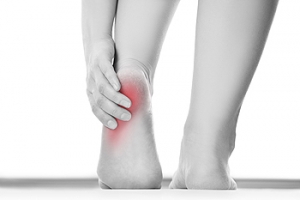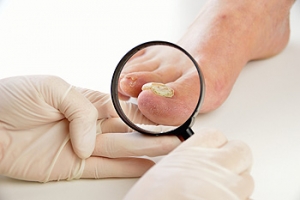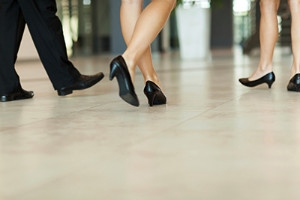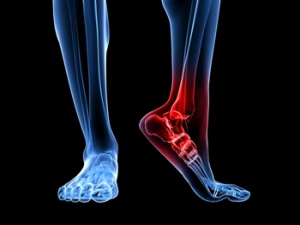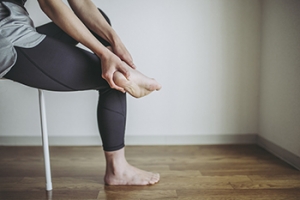Featured Articles
Super User
Why Pain in Your Heel May Be Worse in the Morning
There are different conditions that cause stiffness or pain in your heel that gets worse in the morning. Pain from conditions such as plantar fasciitis—where the long band of tissue on the bottom of the foot becomes inflamed—can be worse in the morning because blood supply to the feet is reduced while you sleep. Similarly, an inflammation of the tissue that connects the heel bone with the calf muscles (Achilles tendinitis) can also be more painful upon waking. This can also be caused by poor circulation, or the fact that calf muscles are shortened while at rest and may become painful when they are stretched as you take your first steps. Unlike plantar fasciitis, however, heel pain from Achilles tendinitis typically does not subside after moving around and warming up the heel. If you have any pain in your heel, seek the care of a podiatrist to determine its cause and the best course of treatment.
Many people suffer from bouts of heel pain. For more information, contact Dr. Dean D. Hinners of Illinois. Our doctor can provide the care you need to keep you pain-free and on your feet.
Causes of Heel Pain
Heel pain is often associated with plantar fasciitis. The plantar fascia is a band of tissues that extends along the bottom of the foot. A rip or tear in this ligament can cause inflammation of the tissue.
Achilles tendonitis is another cause of heel pain. Inflammation of the Achilles tendon will cause pain from fractures and muscle tearing. Lack of flexibility is also another symptom.
Heel spurs are another cause of pain. When the tissues of the plantar fascia undergo a great deal of stress, it can lead to ligament separation from the heel bone, causing heel spurs.
Why Might Heel Pain Occur?
- Wearing ill-fitting shoes
- Wearing non-supportive shoes
- Weight change
- Excessive running
Treatments
Heel pain should be treated as soon as possible for immediate results. Keeping your feet in a stress-free environment will help. If you suffer from Achilles tendonitis or plantar fasciitis, applying ice will reduce the swelling. Stretching before an exercise like running will help the muscles. Using all these tips will help make heel pain a condition of the past.
If you have any questions please contact one of our offices located in Metropolis and Eldorado, IL . We offer the newest diagnostic and treatment technologies for all your foot and ankle needs.
How to Avoid Achilles Tendon Injuries
 If you find yourself engaging in vigorous activity, but only on the weekends, this is something you should be aware of. Injuries like Achilles tendonitis, or a ruptured Achilles tendon, can happen very quickly. For us non-professional athletes that don’t have time in our busy schedules to reach pinnacles of muscular strength, we are more susceptible to these acute injuries. The Achilles tendon connects the heel bone to the calf muscles and is essential to being able to walk. If the tendon ruptures, surgery will be necessary in order to repair this very painful injury. Achilles tendonitis is when the tendon becomes inflamed, typically due to overuse or not stretching beforehand. Both of these conditions can be treated by a podiatrist and if you experiencing intense heel pain you should consult with one immediately. In order to avoid these injuries, strengthening the tendon by gradually stressing them over time may be helpful. And always remember to stretch!
If you find yourself engaging in vigorous activity, but only on the weekends, this is something you should be aware of. Injuries like Achilles tendonitis, or a ruptured Achilles tendon, can happen very quickly. For us non-professional athletes that don’t have time in our busy schedules to reach pinnacles of muscular strength, we are more susceptible to these acute injuries. The Achilles tendon connects the heel bone to the calf muscles and is essential to being able to walk. If the tendon ruptures, surgery will be necessary in order to repair this very painful injury. Achilles tendonitis is when the tendon becomes inflamed, typically due to overuse or not stretching beforehand. Both of these conditions can be treated by a podiatrist and if you experiencing intense heel pain you should consult with one immediately. In order to avoid these injuries, strengthening the tendon by gradually stressing them over time may be helpful. And always remember to stretch!
Achilles tendon injuries need immediate attention to avoid future complications. If you have any concerns, contact Dr. Dean D. Hinners of Illinois. Our doctor can provide the care you need to keep you pain-free and on your feet.
What Is the Achilles Tendon?
The Achilles tendon is a tendon that connects the lower leg muscles and calf to the heel of the foot. It is the strongest tendon in the human body and is essential for making movement possible. Because this tendon is such an integral part of the body, any injuries to it can create immense difficulties and should immediately be presented to a doctor.
What Are the Symptoms of an Achilles Tendon Injury?
There are various types of injuries that can affect the Achilles tendon. The two most common injuries are Achilles tendinitis and ruptures of the tendon.
Achilles Tendinitis Symptoms
- Inflammation
- Dull to severe pain
- Increased blood flow to the tendon
- Thickening of the tendon
Rupture Symptoms
- Extreme pain and swelling in the foot
- Total immobility
Treatment and Prevention
Achilles tendon injuries are diagnosed by a thorough physical evaluation, which can include an MRI. Treatment involves rest, physical therapy, and in some cases, surgery. However, various preventative measures can be taken to avoid these injuries, such as:
- Thorough stretching of the tendon before and after exercise
- Strengthening exercises like calf raises, squats, leg curls, leg extensions, leg raises, lunges, and leg presses
If you have any questions please feel free to contact one of our offices located in Metropolis and Eldorado, IL . We offer the newest diagnostic tools and technology to treat your foot and ankle needs.
How to Keep Diabetic Feet Healthy
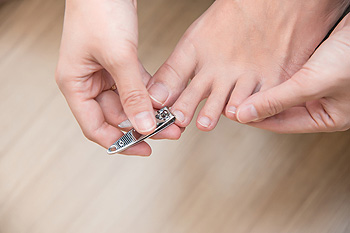 Many diabetics incur nerve damage, often making it difficult to feel sores, blisters, or cuts. Checking the feet nightly can be helpful in preventing infections; however, it may be difficult for the diabetic patient to check their feet due to arthritis, diminished eyesight or possible back problems. Having someone check the feet daily or using a small mirror may be beneficial in observing the soles of the feet. Symptoms to look for include any type of irritation, redness, or callus; additionally, paying extra attention to the toes and the ball of the foot is crucial in noticing foot ulcers. Moisturizing is necessary in preventing dry skin, which may cause cracked heels that can become infected. If an electric blanket is used, it may be wise to not use it because of reduced feeling in the feet. Additionally, ice packs can cause numbness in the feet and may not be recommended for this reason. Trimming the toenails is important to do with clippers that are designed for toenails, thereby preventing injuries to the foot. Please consult your podiatrist for advice in keeping your feet healthy
Many diabetics incur nerve damage, often making it difficult to feel sores, blisters, or cuts. Checking the feet nightly can be helpful in preventing infections; however, it may be difficult for the diabetic patient to check their feet due to arthritis, diminished eyesight or possible back problems. Having someone check the feet daily or using a small mirror may be beneficial in observing the soles of the feet. Symptoms to look for include any type of irritation, redness, or callus; additionally, paying extra attention to the toes and the ball of the foot is crucial in noticing foot ulcers. Moisturizing is necessary in preventing dry skin, which may cause cracked heels that can become infected. If an electric blanket is used, it may be wise to not use it because of reduced feeling in the feet. Additionally, ice packs can cause numbness in the feet and may not be recommended for this reason. Trimming the toenails is important to do with clippers that are designed for toenails, thereby preventing injuries to the foot. Please consult your podiatrist for advice in keeping your feet healthy
Diabetic foot care is important in preventing foot ailments such as ulcers. If you are suffering from diabetes or have any other concerns about your feet, contact Dr. Dean D. Hinners from Illinois. Our doctor can provide the care you need to keep you pain-free and on your feet.
Diabetic Foot Care
Diabetes affects millions of people every year. The condition can damage blood vessels in many parts of the body, especially the feet. Because of this, taking care of your feet is essential if you have diabetes, and having a podiatrist help monitor your foot health is highly recommended.
The Importance of Caring for Your Feet
- Routinely inspect your feet for bruises or sores.
- Wear socks that fit your feet comfortably.
- Wear comfortable shoes that provide adequate support.
Patients with diabetes should have their doctor monitor their blood levels, as blood sugar levels play such a huge role in diabetic care. Monitoring these levels on a regular basis is highly advised.
It is always best to inform your healthcare professional of any concerns you may have regarding your feet, especially for diabetic patients. Early treatment and routine foot examinations are keys to maintaining proper health, especially because severe complications can arise if proper treatment is not applied.
If you have any questions please feel free to contact one of our offices located in Metropolis and Eldorado, IL . We offer the newest diagnostic and treatment technologies for all your foot and ankle needs.
How to Prevent Toenail Fungus
 A fungal infection of the toenail is a common condition that many people are afflicted with. It’s prevalent in people who are diabetic or who have compromised immune systems, in addition to enduring any trauma that may have affected the toes. This type of fungus generally lives in moist environments and is typically found on public shower room floors. Some of the symptoms that may be experienced can include the nails becoming thick, yellow or brown, and the nails lifting up, breaking easily. It’s possible to prevent this fungus from invading your toenails by keeping your feet clean and dry, especially in between the toes. Additionally, wearing proper footwear in public showers will also aid in the toes being protected. Maintaining clean and short nails may be beneficial in controlling this condition. Please consider a consultation with a podiatrist for information and treatment options that are correct for you.
A fungal infection of the toenail is a common condition that many people are afflicted with. It’s prevalent in people who are diabetic or who have compromised immune systems, in addition to enduring any trauma that may have affected the toes. This type of fungus generally lives in moist environments and is typically found on public shower room floors. Some of the symptoms that may be experienced can include the nails becoming thick, yellow or brown, and the nails lifting up, breaking easily. It’s possible to prevent this fungus from invading your toenails by keeping your feet clean and dry, especially in between the toes. Additionally, wearing proper footwear in public showers will also aid in the toes being protected. Maintaining clean and short nails may be beneficial in controlling this condition. Please consider a consultation with a podiatrist for information and treatment options that are correct for you.
For more information about treatment, contact Dr. Dean D. Hinners of Illinois. Our doctor can provide the care you need to keep you pain-free and on your feet.
Toenail Fungus Treatment
Toenail fungus is a condition that affects many people and can be especially hard to get rid of. Fortunately, there are several methods to go about treating and avoiding it.
Antifungals & Deterrence
Oral antifungal medicine has been shown to be effective in many cases. It is important to consult with a podiatrist to determine the proper regiment for you, or potentially explore other options.
Applying foot powder on the feet and shoes helps keep the feet free of moisture and sweat.
Sandals or open toed shoes – Wearing these will allow air movement and help keep feet dry. They also expose your feet to light, which fungus cannot tolerate. Socks with moisture wicking material also help as well.
If you have any questions please feel free to contact one of our offices located in Metropolis and Eldorado, IL . We offer the newest diagnostic tools and technology to treat your foot and ankle needs.
How to Prevent Corns
 When the foot incurs abnormal pressure from wearing incorrect footwear, a corn may develop. A corn is a small area of thickened skin, usually appearing on the tops of the toes or the balls of the feet. These are typically referred to as hard corns, often producing redness, swelling, and pain. Soft corns are usually found between the toes, appearing white and having a rubbery texture. Both types of corns are produced by excessive friction, typically caused by wearing ill fitting shoes and from moisture accumulating between the toes. Many people will develop corns throughout their lives, and it is one of the most common foot ailments. It’s important to prevent corns from developing by being aware of specific areas of the foot that often endure pressure. If you stand for most of the day, it’s suggested to take ample time to find shoes that fit properly. Additionally, the skin will benefit significantly by being moisturized. Please consult with a podiatrist for a proper diagnosis and information on how painful corns can be removed.
When the foot incurs abnormal pressure from wearing incorrect footwear, a corn may develop. A corn is a small area of thickened skin, usually appearing on the tops of the toes or the balls of the feet. These are typically referred to as hard corns, often producing redness, swelling, and pain. Soft corns are usually found between the toes, appearing white and having a rubbery texture. Both types of corns are produced by excessive friction, typically caused by wearing ill fitting shoes and from moisture accumulating between the toes. Many people will develop corns throughout their lives, and it is one of the most common foot ailments. It’s important to prevent corns from developing by being aware of specific areas of the foot that often endure pressure. If you stand for most of the day, it’s suggested to take ample time to find shoes that fit properly. Additionally, the skin will benefit significantly by being moisturized. Please consult with a podiatrist for a proper diagnosis and information on how painful corns can be removed.
If you have any concerns regarding your feet and ankles, contact Dr. Dean D. Hinners of Illinois. Our doctor will treat your foot and ankle needs.
Corns: What Are They? and How Do You Get Rid of Them?
Corns can be described as areas of the skin that have thickened to the point of becoming painful or irritating. They are often layers and layers of the skin that have become dry and rough, and are normally smaller than calluses.
Ways to Prevent Corns
There are many ways to get rid of painful corns such as wearing:
- Well-fitting socks
- Comfortable shoes that are not tight around your foot
- Shoes that offer support
Treating Corns
Treatment of corns involves removing the dead skin that has built up in the specific area of the foot. Consult with Our doctor to determine the best treatment option for your case of corns.
If you have any questions please feel free to contact one of our offices located in Metropolis and Eldorado, IL . We offer the newest diagnostic and treatment technologies for all your foot and ankle needs.
Can High Heels Damage My Feet?
 Many women choose to wear high heels to increase confidence, height, and the muscle tone of the leg. These perceived benefits may not outweigh the damage the feet may incur as a result of wearing this type of shoe. The arch of the foot is typically affected, which may lead to pain and discomfort. When the heel of the foot is raised, the ligaments of the arch become weak, and may result in the development of a condition referred to as fallen arches or flat feet. There is generally not enough room for the toes to move about freely, and this may result in a conditions such as hammertoe. The feet absorb the body’s mass, and the weight becomes redistributed, which affects the ball of the foot when high heels are worn. If high heels are frequently worn, the Achilles tendon may become shorter, causing severe pain. Recent research has suggested that wearing shoes with a shorter heel can prevent many foot injuries from occurring.
Many women choose to wear high heels to increase confidence, height, and the muscle tone of the leg. These perceived benefits may not outweigh the damage the feet may incur as a result of wearing this type of shoe. The arch of the foot is typically affected, which may lead to pain and discomfort. When the heel of the foot is raised, the ligaments of the arch become weak, and may result in the development of a condition referred to as fallen arches or flat feet. There is generally not enough room for the toes to move about freely, and this may result in a conditions such as hammertoe. The feet absorb the body’s mass, and the weight becomes redistributed, which affects the ball of the foot when high heels are worn. If high heels are frequently worn, the Achilles tendon may become shorter, causing severe pain. Recent research has suggested that wearing shoes with a shorter heel can prevent many foot injuries from occurring.
High heels have a history of causing foot and ankle problems. If you have any concerns about your feet or ankles, contact Dr. Dean D. Hinners from Illinois. Our doctor can provide the care you need to keep you pain-free and on your feet.
Effects of High Heels on the Feet
High heels are popular shoes among women because of their many styles and societal appeal. Despite this, high heels can still cause many health problems if worn too frequently.
Which Parts of My Body Will Be Affected by High Heels?
- Ankle Joints
- Achilles Tendon – May shorten and stiffen with prolonged wear
- Balls of the Feet
- Knees – Heels cause the knees to bend constantly, creating stress on them
- Back – They decrease the spine’s ability to absorb shock, which may lead to back pain. The vertebrae of the lower back may compress.
What Kinds of Foot Problems Can Develop from Wearing High Heels?
- Corns
- Calluses
- Hammertoe
- Bunions
- Morton’s Neuroma
- Plantar Fasciitis
How Can I Still Wear High Heels and Maintain Foot Health?
If you want to wear high heeled shoes, make sure that you are not wearing them every day, as this will help prevent long term physical problems. Try wearing thicker heels as opposed to stilettos to distribute weight more evenly across the feet. Always make sure you are wearing the proper shoes for the right occasion, such as sneakers for exercising. If you walk to work, try carrying your heels with you and changing into them once you arrive at work. Adding inserts to your heels can help cushion your feet and absorb shock. Full foot inserts or metatarsal pads are available.
If you have any questions please feel free to contact one of our offices located in Metropolis and Eldorado, IL . We offer the newest diagnostic and treatment technologies for all your foot and ankle needs.
Read more about Effect of High Heels on the FeetWhat to Look For When Buying Running or Walking Shoes
 Typically, running shoes are made with considerably heavier cushioning than walking shoes. Fitness walkers have different needs than runners, as walking has much less impact on the feet. One thing to look for when buying running shoes is to make sure the foot can bend in the shoe. Another suggestion is to look for a shoe with a low heel; this can support runners who land on the balls of their feet. Cushioned shoes are favored for those who walk long distances or on hard surfaces. Additionally, shoes that are made from lighter materials will be more comfortable because they are not as heavy.
Typically, running shoes are made with considerably heavier cushioning than walking shoes. Fitness walkers have different needs than runners, as walking has much less impact on the feet. One thing to look for when buying running shoes is to make sure the foot can bend in the shoe. Another suggestion is to look for a shoe with a low heel; this can support runners who land on the balls of their feet. Cushioned shoes are favored for those who walk long distances or on hard surfaces. Additionally, shoes that are made from lighter materials will be more comfortable because they are not as heavy.
For more information about walking shoes versus running shoes, consult with Dr. Dean D. Hinners from Illinois. Our doctor can measure your feet to determine what your needs are and help you find an appropriate pair of footwear.
Foot Health: The Differences between Walking & Running Shoes
There are great ways to stay in shape: running and walking are two great exercises to a healthy lifestyle. It is important to know that running shoes and walking shoes are not interchangeable. There is a key difference on how the feet hit the ground when someone is running or walking. This is why one should be aware that a shoe is designed differently for each activity.
You may be asking yourself what the real differences are between walking and running shoes and the answers may shock you.
Differences
Walking doesn’t involve as much stress or impact on the feet as running does. However, this doesn’t mean that you should be any less prepared. When you’re walking, you land on your heels and have your foot roll forward. This rolling motion requires additional support to the feet.
Flexibility – Walking shoes are designed to have soft, flexible soles. This allows the walker to push off easily with each step.
If you have any questions, please feel free to contact one of our offices located in Metropolis and Eldorado, IL . We offer the newest diagnostic and treatment technologies for all your foot care needs.
Differences between Walking and Running Shoes
Both running and walking are great exercises, but should a person wear the same shoes for both activities? The answer is no, because there is a difference between the way a person’s feet hit the ground when they are walking and when they are running. Therefore, the shoes for each activity are designed differently. Before you begin any exercise program it is always recommended that you speak with your doctor or podiatrist.
Walking is a low impact exercise that is often recommended by doctors to their patients. While walking is a simple activity, it still requires some degree of preparation. If you think about walking and how your feet strike the ground as you move, you will notice that your heel hits the ground first before your foot continues to roll forward and your next step begins. Because of this rolling motion, walking shoes are designed to be more flexible than running shoes. This flexibility helps the walker push off with each step taken.
Because the heel hits the ground first when you walk, walking shoes are designed to absorb most of the shock. Walking shoes should therefore have a beveled or angled heel. The angle of the heel helps absorb the shock and reduces pressure from the ankles. This is especially important for speed walkers, as their feet will hit the ground twice as often as the normal walker.
When people decide to run as a hobby or for their health, they must first realize that running is a high impact exercise. If not done with the proper equipment, running may cause damage to the feet and legs. Running shoes are designed to be more lightweight and to have thicker soles. The thicker soles act as shock absorbers for the rest of the body. Walking shoes often do not have the proper arch support that running shoes do.
A proper fitting shoe can make or break a runner or a walker. If the shoes are too big, their feet will slide back and forth inside the shoe and cause blisters. Whether you will be running or walking, the right equipment can make all of the difference in the world.
What’s Causing My Heel Pain?
 The heel is comprised of numerous tendons, ligaments, and fatty tissue. Common causes of pain in the heel may include possible stress fractures, bursitis, and obesity, and can typically be treated with ice packs, foot massages, and exercises designed to flex the foot. Probable diagnosis may include plantar fasciitis, heel spurs, and Sever’s disease. Refraining from activities that may have caused the pain not only reduces the stress on the heel, but will help in healing the tendons. This pain is commonly avoided by choosing shoes with laces for a firmer fit, discarding shoes with heels that are worn, and stretching the foot by warming up before a sports related activity. A consultation with a podiatrist is advised in properly diagnosing the cause of the pain, in addition to discovering the best treatment options available.
The heel is comprised of numerous tendons, ligaments, and fatty tissue. Common causes of pain in the heel may include possible stress fractures, bursitis, and obesity, and can typically be treated with ice packs, foot massages, and exercises designed to flex the foot. Probable diagnosis may include plantar fasciitis, heel spurs, and Sever’s disease. Refraining from activities that may have caused the pain not only reduces the stress on the heel, but will help in healing the tendons. This pain is commonly avoided by choosing shoes with laces for a firmer fit, discarding shoes with heels that are worn, and stretching the foot by warming up before a sports related activity. A consultation with a podiatrist is advised in properly diagnosing the cause of the pain, in addition to discovering the best treatment options available.
Many people suffer from bouts of heel pain. For more information, contact Dr. Dean D. Hinners of Illinois. Our doctor can provide the care you need to keep you pain-free and on your feet.
Causes of Heel Pain
Heel pain is often associated with plantar fasciitis. The plantar fascia is a band of tissues that extends along the bottom of the foot. A rip or tear in this ligament can cause inflammation of the tissue.
Achilles tendonitis is another cause of heel pain. Inflammation of the Achilles tendon will cause pain from fractures and muscle tearing. Lack of flexibility is also another symptom.
Heel spurs are another cause of pain. When the tissues of the plantar fascia undergo a great deal of stress, it can lead to ligament separation from the heel bone, causing heel spurs.
Why Might Heel Pain Occur?
- Wearing ill-fitting shoes
- Wearing non-supportive shoes
- Weight change
- Excessive running
Treatments
Heel pain should be treated as soon as possible for immediate results. Keeping your feet in a stress-free environment will help. If you suffer from Achilles tendonitis or plantar fasciitis, applying ice will reduce the swelling. Stretching before an exercise like running will help the muscles. Using all these tips will help make heel pain a condition of the past.
If you have any questions please contact one of our offices located in Metropolis and Eldorado, IL . We offer the newest diagnostic and treatment technologies for all your foot and ankle needs.
What Is Plantar Fasciitis and Where Does It Occur?
The plantar fascia is the band of tissue on the soles of the feet that connect the front of the foot with the arch and the heel. When that tissue becomes inflamed due to stress or excessive stretching, plantar fasciitis can occur. Factors that can contribute to plantar fasciitis may include prolonged standing without proper footwear support, being overweight, having flat feet, high arches, or tight calf muscles. Pain from plantar fasciitis is often worse after sitting for a long period of time or in the morning, because the plantar fascia can contract while you are inactive or sleeping. If you have heel pain, it is suggested you make an appointment with a podiatrist who can examine you to make a proper diagnosis, and help treat whatever condition you may have using a variety of treatments and therapies.
Plantar fasciitis is a common foot condition that is often caused by a strain injury. If you are experiencing heel pain or symptoms of plantar fasciitis, contact Dr. Dean D. Hinners from Illinois. Our doctor can provide the care you need to keep you pain-free and on your feet.
What Is Plantar Fasciitis?
Plantar fasciitis is one of the most common causes of heel pain. The plantar fascia is a ligament that connects your heel to the front of your foot. When this ligament becomes inflamed, plantar fasciitis is the result. If you have plantar fasciitis you will have a stabbing pain that usually occurs with your first steps in the morning. As the day progresses and you walk around more, this pain will start to disappear, but it will return after long periods of standing or sitting.
What Causes Plantar Fasciitis?
- Excessive running
- Having high arches in your feet
- Other foot issues such as flat feet
- Pregnancy (due to the sudden weight gain)
- Being on your feet very often
There are some risk factors that may make you more likely to develop plantar fasciitis compared to others. The condition most commonly affects adults between the ages of 40 and 60. It also tends to affect people who are obese because the extra pounds result in extra stress being placed on the plantar fascia.
Prevention
- Take good care of your feet – Wear shoes that have good arch support and heel cushioning.
- Maintain a healthy weight
- If you are a runner, alternate running with other sports that won’t cause heel pain
There are a variety of treatment options available for plantar fasciitis along with the pain that accompanies it. Additionally, physical therapy is a very important component in the treatment process. It is important that you meet with your podiatrist to determine which treatment option is best for you.
If you have any questions, please feel free to contact one of our offices located in Metropolis and Eldorado, IL . We offer the newest diagnostic and treatment technologies for all your foot care needs.
Read more about Plantar Fasciitis
